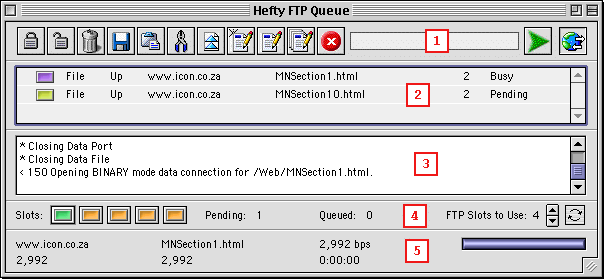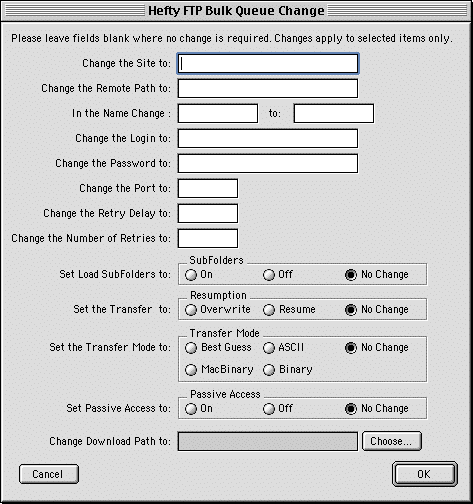


KEY:
[1] Toolbar
[2] Queue List
[3] Server Dialogue
[4] Queue Slot Control
[5] Queue Slot Information
 4.1.1 Place Queue Item On Hold
4.1.1 Place Queue Item On Hold Press this to place any selected queue items on hold. Items placed on hold are just stored in the queue and are not processed until re-activated.
 4.1.2 Re-Activate Queue Item
4.1.2 Re-Activate Queue Item Press this to re-activate any queue items that are on hold or have been held in the queue because of an error.
 4.1.3 Delete Queue Item
4.1.3 Delete Queue Item Use this to delete any selected queue items that are not in progress.
 4.1.4 Save The Queue
4.1.4 Save The Queue Press this to save the queue. Note that the queue is automatically saved every approximately 6 minutes.
 4.1.5 Copy Log To Clipboard
4.1.5 Copy Log To Clipboard Hefty FTP has four FTP and one HTTP download slots. The slot display is selected by pressing the Slot buttons shown to the left of the [4] indicator in the illustration. To copy the log from the selected slot to the clipboard, use this toolbar button.
 4.1.6 Translate Hex values
4.1.6 Translate Hex values Sometimes you will have queue items dragged from some other application that contain hexadecimal-encoded values ( eg: %20 for a space ). Some remote servers accept this encoding, while others require these encoded characters to be decoded. To decode hex values in a queue item, select the item and press this button.
 4.1.7 Toggle Priority
4.1.7 Toggle Priority Hefty FTP allows for two priorities - priority 1 items are transferred before priority 2 items. By default items are placed in the queue at priority 2. To toggle an item's priority between 1 and 2, select it and press this button.
 4.1.8 Enter a URL
4.1.8 Enter a URL If you wish to manually enter or paste a URL into the queue press this button to show a small window allowing you to do so.
 4.1.9 Edit Queue Item
4.1.9 Edit Queue Item To change a single item's values press this button. An edit window will appear allowing you to change the item's parameters.
This function may only be run if the queue is stopped and there are no downloads in progress.
 4.1.10 Bulk Queue Change
4.1.10 Bulk Queue Change Sometimes you might wish to make the same change to many queue items. To do so, select the items and press this button to bring up the Bulk Edit window.
This function may only be run if the queue is stopped and there are no downloads in progress.
 4.1.11 Abort A Transfer
4.1.11 Abort A Transfer This aborts the transfer in a selected slot. The slot is selected by pressing the Slot buttons shown to the left of the [4] indicator in the illustration.

 4.1.12 Start/Stop The Queue
4.1.12 Start/Stop The Queue This starts or stops the processing of the queue.
 4.1.13 Hide The Queue
4.1.13 Hide The Queue This hides the queue window to free up some screen space.
The queue listing shows information about the items in the queue. First is a coloured "pseudo-LED" giving easy visual feedback about an item's status. Next are shown:
* File or Folder as appropriate
* Up, Down or HTTP describing whether the item is an upload, download or HTTP ( web ) download.
* The remote site name
* The file name
* The status of the item
The queue is automatically purged of successful transfers. Items that result in errors are left for your information, and should be manually deleted.
This shows the Hefty FTP dialogue with the server for the selected queue slot.
The section marked [4] in the illustration shows queue status information, and allows you to monitor the five queue slots. You may select a slot to monitor by pressing one of the five slot buttons to the left of this section.
You may vary the maximum number of concurrent FTP slots to use by adjusting the up-down arrows to the right of this section. The single HTTP slot is always enabled.
If the queue is running, the chasing-arrows are visible.
The sections marked [3] and [5] in the illustration show you information about the selected slot. The server dialogue marked [3] shows the dialogue between Hefty FTP and the remote server. The section marked [5] shows transfer status information, including remote site, file name, progress of transfer, file size, size already transferred, speed and time left.
Where appropriate screen functions are mirrored by menu items.

You may edit any of the selected item's transfer parameters here. Most of these parameters are explained elsewhere, but note:
* The site is the server address, not the full URL.
* The remote path must be a full path and must begin and end with a "/".

You may use this to make bulk changes to selected queue items. Leave fields blank if no change is required to those parameters. Please note:
* The site is the server address, not the full URL.
* The remote path must be a full path and must begin and end with a "/".
* For changes to file names, any instance of the characters entered in the first field will be changed to the characters in the second field.
Last updated by DocGen on Monday, November 20, 2000 at 8:01:31 am